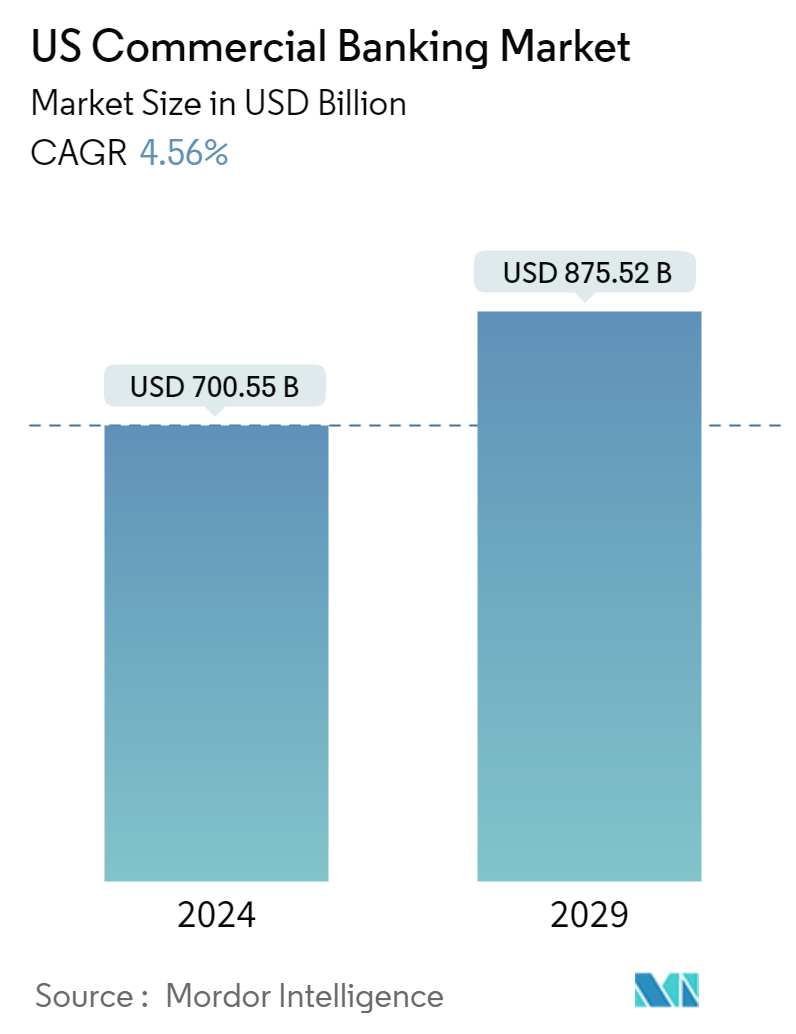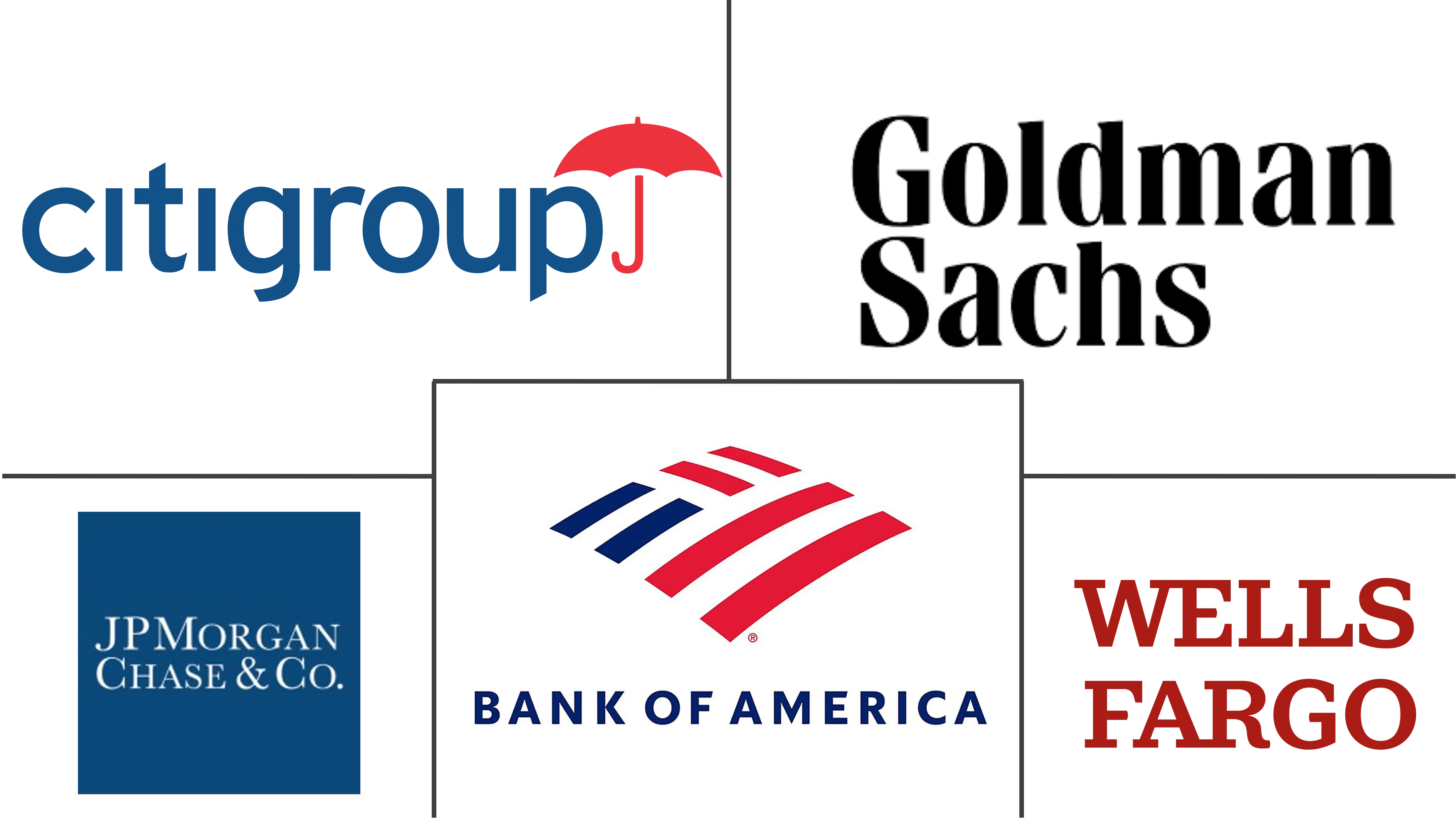Market Size of US Commercial Banking Industry

| Study Period | 2020 - 2029 |
| Base Year For Estimation | 2023 |
| Market Size (2024) | USD 700.55 Billion |
| Market Size (2029) | USD 875.52 Billion |
| CAGR (2024 - 2029) | 4.56 % |
| Market Concentration | High |
Major Players
*Disclaimer: Major Players sorted in no particular order |
US Commercial Banking Market Analysis
The US Commercial Banking Market size is estimated at USD 700.55 billion in 2024, and is expected to reach USD 875.52 billion by 2029, growing at a CAGR of 4.56% during the forecast period (2024-2029).
The primary source of revenue for most banks is business lending, which typically accounts for 60% of their income in addition to their absolute loan portfolio, particularly for provincial and smaller banks. Several leading banks in the United States are investing in innovation as a critical factor for their future growth in some form or another. As for customer portals and applications, in the current computerized banking landscape, IT drives are having similar effects in the back-office as they do in client-facing channels. Corporate and commercial banking revenue in the United States has increased at a rate that is twice the rate of economic growth.
The commercial banking market in the United States is expected to see an increase in partnerships between fintech firms and digital lending companies for payment collections. Open banking is expected to reshape the competition in the market in the next few years. Banks that invest in capabilities are projected to position themselves well to remain strong consumer brands. However, loan growth has increased in the last few months, with annual growth slowing from nearly double digits late the previous year to around 9%, indicating that tighter conditions are starting to dampen bank credit growth.
US Commercial Banking Industry Segmentation
Commercial banks, as financial institutions, offer a spectrum of services to the public, encompassing withdrawals, deposits, and investment lending. Borrowing and lending are the two main components of commercial banking. This report will provide a detailed analysis of the US commercial banking market. The report delves into market dynamics and emerging trends in segments and regional markets and offers insights into various product and application types. It also analyses the key players and the competitive landscape.
The US commercial banking market is segmented by product and function. By product, the market is segmented into commercial lending, treasury management, syndicated loans, capital markets, and other products. By function, the market is segmented into accepting deposits, advancing loans, credit creation, financing foreign trade, agency services, and other functions. The report offers market sizes and forecasts in terms of value (USD) for all the above segments.
| By Product | |
| Commercial Lending | |
| Treasury Management | |
| Syndicated Loans | |
| Capital Market | |
| Other Products |
| By Function | |
| Accepting Deposits | |
| Advancing Loans | |
| Credit Creation | |
| Financing Foreign Trade | |
| Agency Services | |
| Other Functions |
US Commercial Banking Market Size Summary
The US commercial banking industry is poised for growth, driven by strategic investments in digital innovation and partnerships with FinTech firms. As banks increasingly focus on enhancing their digital platforms, such as Citi's CitiDirect®, they are positioning themselves to meet the evolving demands of their commercial clients. The integration of open banking is expected to further transform the competitive landscape, offering consumers more personalized and flexible financial services. This shift towards digital transformation is not only improving customer engagement but also streamlining operations, allowing banks to maintain their competitive edge in a rapidly changing market.
Despite the promising growth trajectory, the industry faces challenges such as tightening credit conditions and the need to adapt to the fluidity of digital commerce. The pandemic has accelerated the adoption of digital payments and financial services, but maintaining pace with innovation remains a challenge for some providers. The market is characterized by a high level of competition, with major players like JPMorgan Chase, Bank of America, and Citigroup dominating the landscape. These institutions are leveraging their scale and technological advancements to drive market consolidation and expand their reach, particularly through strategic acquisitions and the development of state-of-the-art financial solutions.
US Commercial Banking Market Size - Table of Contents
-
1. MARKET DYNAMICS
-
1.1 Market Drivers
-
1.1.1 Economic Growth is Driving the Market
-
-
1.2 Market Restraints
-
1.2.1 Cyber Security Threats are Restraining the Market
-
-
1.3 Market Opportunities
-
1.3.1 The Ongoing Rise of Fintech Companies
-
1.3.2 Increased Regulatory Developments in Commercial Banking
-
-
1.4 Porter's Five Forces Analysis
-
1.4.1 Bargaining Power of Suppliers
-
1.4.2 Bargaining Power of Buyers/Consumers
-
1.4.3 Threat of New Entrants
-
1.4.4 Threat of Substitute Products
-
1.4.5 Intensity of Competitive Rivalry
-
-
1.5 Insights on Digital Disruptions and Technological Trends in the US Banking Industry
-
1.6 Impact of COVID-19 on the Market
-
-
2. MARKET SEGMENTATION
-
2.1 By Product
-
2.1.1 Commercial Lending
-
2.1.2 Treasury Management
-
2.1.3 Syndicated Loans
-
2.1.4 Capital Market
-
2.1.5 Other Products
-
-
2.2 By Function
-
2.2.1 Accepting Deposits
-
2.2.2 Advancing Loans
-
2.2.3 Credit Creation
-
2.2.4 Financing Foreign Trade
-
2.2.5 Agency Services
-
2.2.6 Other Functions
-
-
US Commercial Banking Market Size FAQs
How big is the US Commercial Banking Market?
The US Commercial Banking Market size is expected to reach USD 700.55 billion in 2024 and grow at a CAGR of 4.56% to reach USD 875.52 billion by 2029.
What is the current US Commercial Banking Market size?
In 2024, the US Commercial Banking Market size is expected to reach USD 700.55 billion.

